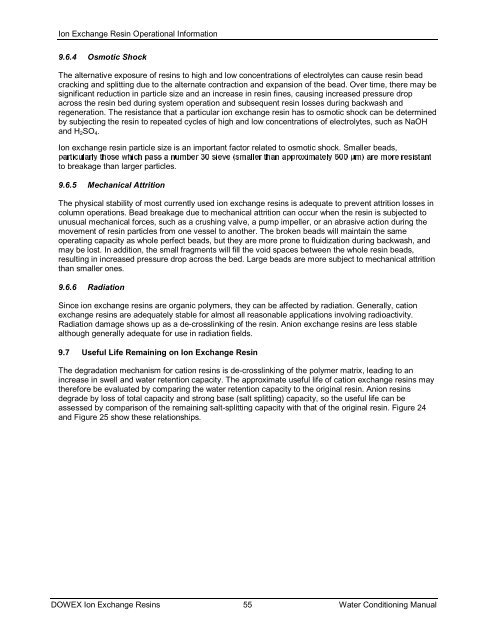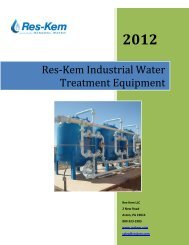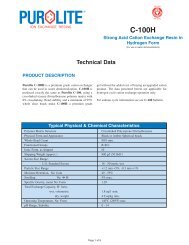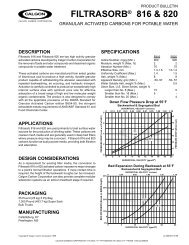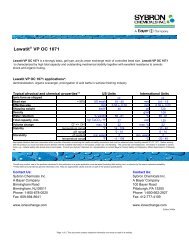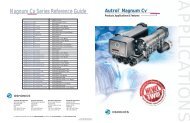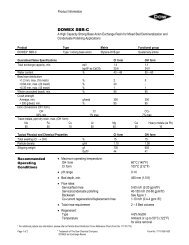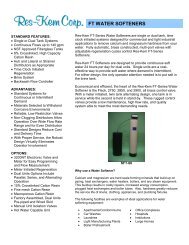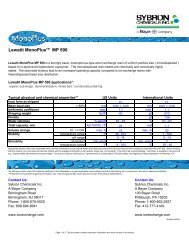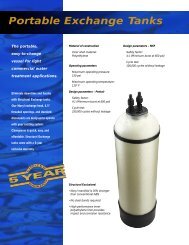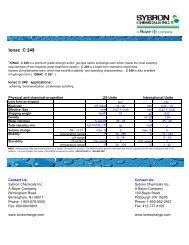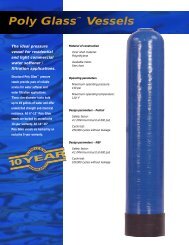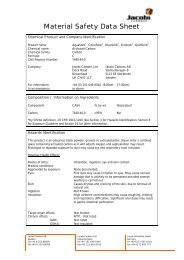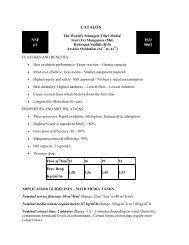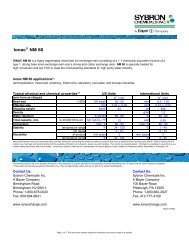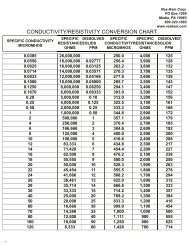DOWEX Ion Exchange Resins WATER CONDITIONING MANUAL
DOWEX Ion Exchange Resins WATER CONDITIONING MANUAL
DOWEX Ion Exchange Resins WATER CONDITIONING MANUAL
You also want an ePaper? Increase the reach of your titles
YUMPU automatically turns print PDFs into web optimized ePapers that Google loves.
<strong>Ion</strong> <strong>Exchange</strong> Resin Operational Information<br />
9.6.4 Osmotic Shock<br />
The alternative exposure of resins to high and low concentrations of electrolytes can cause resin bead<br />
cracking and splitting due to the alternate contraction and expansion of the bead. Over time, there may be<br />
significant reduction in particle size and an increase in resin fines, causing increased pressure drop<br />
across the resin bed during system operation and subsequent resin losses during backwash and<br />
regeneration. The resistance that a particular ion exchange resin has to osmotic shock can be determined<br />
by subjecting the resin to repeated cycles of high and low concentrations of electrolytes, such as NaOH<br />
and H2SO4.<br />
<strong>Ion</strong> exchange resin particle size is an important factor related to osmotic shock. Smaller beads,<br />
��������������������������������������������������������������������à ������������������<br />
to breakage than larger particles.<br />
9.6.5 Mechanical Attrition<br />
The physical stability of most currently used ion exchange resins is adequate to prevent attrition losses in<br />
column operations. Bead breakage due to mechanical attrition can occur when the resin is subjected to<br />
unusual mechanical forces, such as a crushing valve, a pump impeller, or an abrasive action during the<br />
movement of resin particles from one vessel to another. The broken beads will maintain the same<br />
operating capacity as whole perfect beads, but they are more prone to fluidization during backwash, and<br />
may be lost. In addition, the small fragments will fill the void spaces between the whole resin beads,<br />
resulting in increased pressure drop across the bed. Large beads are more subject to mechanical attrition<br />
than smaller ones.<br />
9.6.6 Radiation<br />
Since ion exchange resins are organic polymers, they can be affected by radiation. Generally, cation<br />
exchange resins are adequately stable for almost all reasonable applications involving radioactivity.<br />
Radiation damage shows up as a de-crosslinking of the resin. Anion exchange resins are less stable<br />
although generally adequate for use in radiation fields.<br />
9.7 Useful Life Remaining on <strong>Ion</strong> <strong>Exchange</strong> Resin<br />
The degradation mechanism for cation resins is de-crosslinking of the polymer matrix, leading to an<br />
increase in swell and water retention capacity. The approximate useful life of cation exchange resins may<br />
therefore be evaluated by comparing the water retention capacity to the original resin. Anion resins<br />
degrade by loss of total capacity and strong base (salt splitting) capacity, so the useful life can be<br />
assessed by comparison of the remaining salt-splitting capacity with that of the original resin. Figure 24<br />
and Figure 25 show these relationships.<br />
<strong>DOWEX</strong> <strong>Ion</strong> <strong>Exchange</strong> <strong>Resins</strong> 55 Water Conditioning Manual


